Jeff Allison presents the first of a two-part tribute recognizing Alfa Romeo’s 100th anniversary with a selection of images of Alfas on the track at races from 1959 to 1974.
Words and Photos by Jeff Allison
Before I go further, I should disclose I’m the editor of Prancing Horse, the quarterly magazine of the Ferrari Club of America. Okay, give me a break—Ferraris are Italian aren’t they? In writing about Alfa Romeos, I’m exposing a long lingering soft spot in my heart. In Alfa’s 100th year, I wanted to do my part to recognize the cars with the unlikely name in Italian of Anonima Lombarda Fabbrica Automobili or A.L.F.A. that later joined forces with Società Anonima Ing. Nicola Romeo & Co. to become Alfa Romeo.
 I’ve enjoyed the exciting little Alfa road cars, such as the Giulietta, Giulia and other good and not-so-good models over the years, but I’m a diehard racing fan. I’ve seen many Alfas race in club, national and international events since 1958. In fact, it seems there was usually an Alfa at many of those races. I thought I’d do my part to pay tribute to Alfa’s 100 years by sharing a selection of photos of Alfas on the track, certainly not all inclusive, that I’ve taken over the years.
I’ve enjoyed the exciting little Alfa road cars, such as the Giulietta, Giulia and other good and not-so-good models over the years, but I’m a diehard racing fan. I’ve seen many Alfas race in club, national and international events since 1958. In fact, it seems there was usually an Alfa at many of those races. I thought I’d do my part to pay tribute to Alfa’s 100 years by sharing a selection of photos of Alfas on the track, certainly not all inclusive, that I’ve taken over the years.
I have the Sebring 12 Hours to blame for sparking my interest (maybe a better descriptor would be addiction to) in motor racing. Since 1958, I’ve been fortunate to attend races around the U. S. and in Europe, ranging from the most basic of SCCA races of the late 1950s on courses lined with upside down peach baskets to major international sports car races at legendary road racing circuits, such as Brands Hatch, Le Mans, Sebring and Silverstone, in the 1960s-1970s. These were the days when race drivers were race drivers no matter the type car as they often raced alternate weekends in sports cars and F1. The photos are but a small snapshot (pun intended!) of a relatively short period of Alfa’s extensive and glorious 100-year history. I must admit that I fell in love with the 6C and 8C Alfas that I’ve seen on the Colorado Grand and wish I’d been around in their heyday, but then I wouldn’t have been around to see and photograph what I did. Enjoy!

At the gloomy and rainy Sebring 12 Hours on March 22, 1959, the little Giulietta Super Veloce (#54) of Fred Van Beuren, Sr. and Javier and Adolfo Velasquez shows some excessive roll exiting the Webster Turn ahead of the John Bentley and John Gordon OSCA S187N (See VT, September 9, 2009, Sebring 1960: John and Jack Win the Index). The Mexican trio won the Grand Touring 1,300-cc class in the Alfa. The race was run on the spacious 5.2-mile course fashioned from the runways, taxiways and access roads of the former B-17 WW II training base called Hendricks Field, which was now Sebring’s municipal airport. Can you identify the aircraft in the background? Sebring impresario Alec Ulmann converted surplus wartime aircraft to civilian use or overhauled them for the military of numerous small nations, storing aircraft randomly around Sebring’s wide-open spaces.
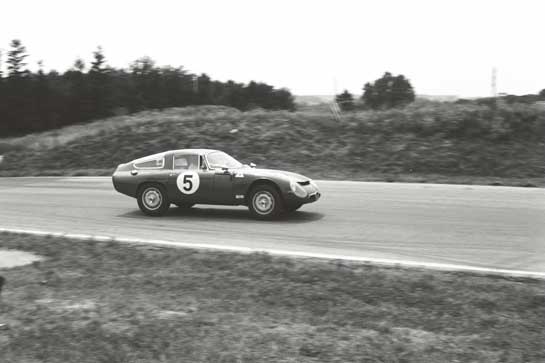
In the race for manufacturers’ points in the United States Road Racing Championship, Ohioan Chuck Stoddard, driving his Giulia TZ1 (#5), won the GT2 class and finished sixth overall at Meadowdale International Raceway (near Carpentersville, Illinois) on August 9, 1964. Stoddard, who went on to be well known in Porsche circles, was competing against the mighty Shelby-American Cobras of Bob Holbert and Ken Miles (winners) and other Cobras in the 120-mile race on the unique 3.27-mile road racing course that included a steeply banked 180-degree turn called the Monza Wall.

Giulia TZ2 (#44) entrant Nicolas Koob has to be one of the few sports car racing drivers from Luxembourg. Here he scurries along one of the many straights of the 8.364-mile circuit at Le Mans during the 24 Hours of Le Mans on June 19-20, 1965. Teamed with Frenchman Alain Finkelstein, the little car looked quite small on the immense circuit before retiring after 218 laps (1,823 miles) with problems with its 1,600-cc engine.
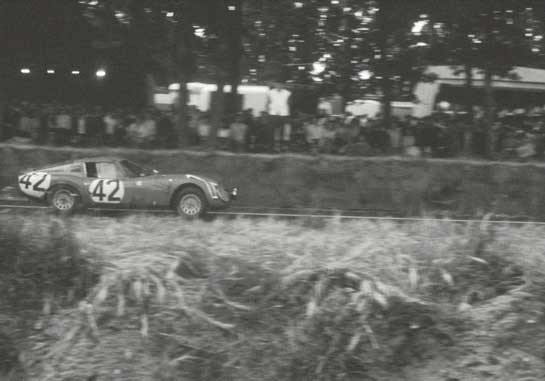
The Autodelta (Alfa’s racing arm) Giulia TZ2 (#42) of Italians Giacomo Russo and Carlo Zuccoli completed only 22 laps (just 184 miles) before retiring with engine problems at the 1965 Le Mans 24 Hours.

At the 12 Hours of Sebring on March 20, 1971, Autodelta boss Carlo Chiti (black rimmed glasses behind the right rear wheel) watched over Alfa’s Type 33/3 models racing for the 1971 manufacturers’ championship.

Alfa and Autodelta began the 1971 season with a 3-4 finish behind two Porsche 917Ks at the opening round in Buenos Aires but skipped the Daytona 24 Hours because Chiti believed special cars were needed for the high-speed events at Daytona and Le Mans. However, Alfa was back in the fray at Sebring for the third event with three of their 33/3 cars. The three-liter Group 6 Alfas couldn’t match the speed of the five-liter Group 5 John Wyer-managed Porsche 917s of Gulf Team Porsche and the North American Racing Team and Roger Penske 512 S and M models nor the lone factory entry of the new three-liter Ferrari 312 P(B). However, the Alfa’s could compete with their reliability, strategy and consistency.
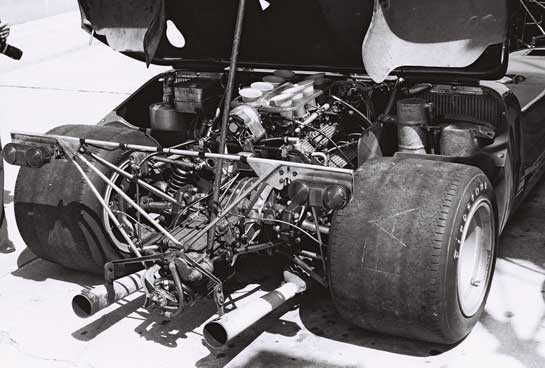
The Type 33, which debuted in 1967, was getting long in the tooth by 1971 and faced formidable opposition for overall wins from Ferrari and Porsche. Alfa Romeo (read Autodelta) reworked the car, making it lighter, more compact and more powerful by tweaking its 90-degree, 2,998-cc V-8 engine to produce 440-hp coupled to a new five-speed transmission.
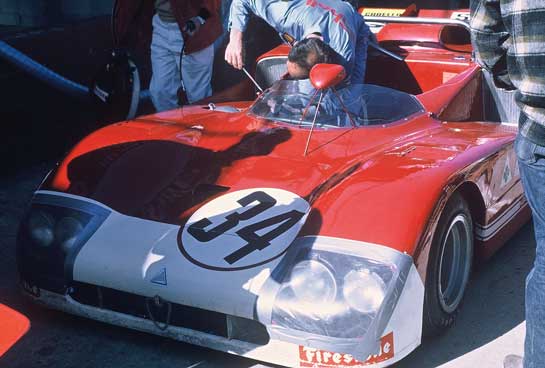
Much of Friday’s practice at Sebring was spent fine tuning the cars with final changes and adjustments, applying decals and shuffling drivers in and out of the three cars before Chiti decided on the final pairings and car assignments for the race. Here, during practice, the #34 33/3 already has its white nose identification and a mechanic works on the windscreen.
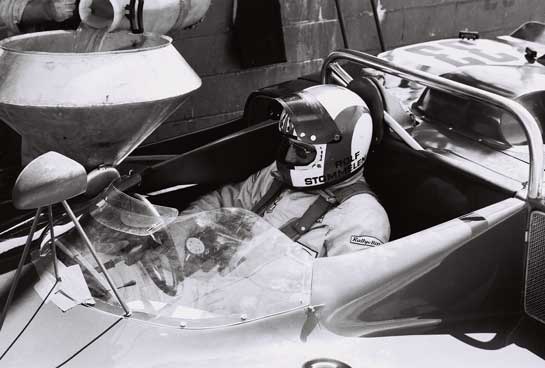
German Rolf Stommelen shared 33/3 (#33) with Italian Giovanni ‘Nanni’ Galli, and the pair finished second overall and first in the Prototype 3000 class. Stommelen raced F1 in 1971 with the Auto Motor Und Sport-Eifelland Team in a Surtees TS9, and Galli raced F1 with the STP March Racing Team in a March 711. Stommelen sits in the car while fuel is added before going out to practice.
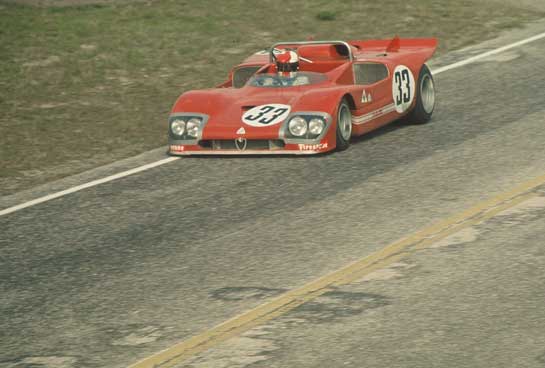
Stommelen sets the 33/3 (#33) up for the Esses as he approaches the MG bridge. He and Galli led for a time, completing 257 laps (1,336 miles) to the 260 of winners Vic Elford and Gerard Larrousse in a Martini & Rossi Racing Team Porsche 917K.

Targa Florio hero and former Ferrari works sports car driver Italian Nino Vaccarella strikes a pose on the Sebring pit wall.
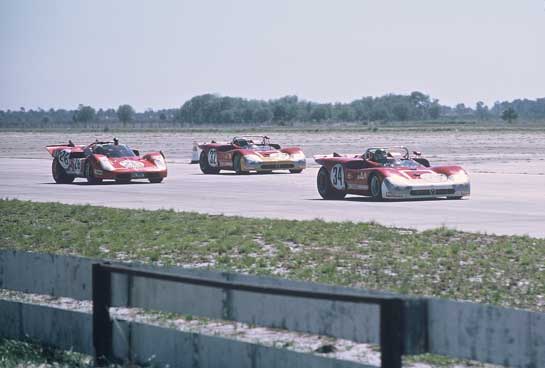
Pictured as they trundle down Sebring’s 4,630-ft back straight (Sebring Airport’s easy-west runway) to take the start are the #34 33/3 (white nose) of Vaccarella and Dutchman Toine Hezemans, the #32 33/3 (yellow nose) of Italian Andrea de Adamich and Frenchman Henri Pescarolo and the NART (Luigi Chinetti, Sr.) Ferrari 512 S (#26) of Chuck Parsons and David Weir. Pescarolo raced F1 for the Frank Williams Racing Cars Team in a March 701 in 1971. De Adamich and Pescarolo were joined later in #32 by Vaccarella, and the trio completed an excellent 2-3 finish for the Autodelta team by finishing third overall and second in the Prototype 3000 class. The trio finished nine laps behind the second-placed sister 33/3 (#33) of Galli and Stommelen.
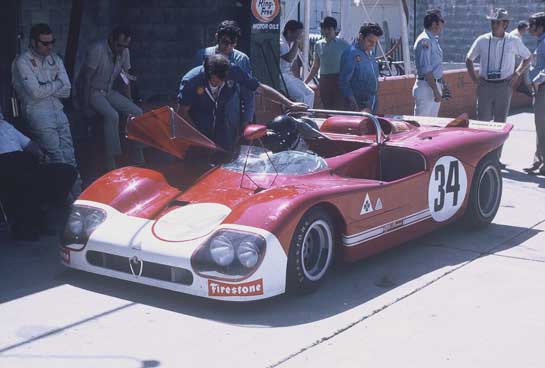
Alfa regular Andrea de Adamich cinches up to go out in the #34 33/3 during practice although he drove #32 in the race. Leaning on the pit wall with his arms crossed is Hezemans, who drove #34 in the race.
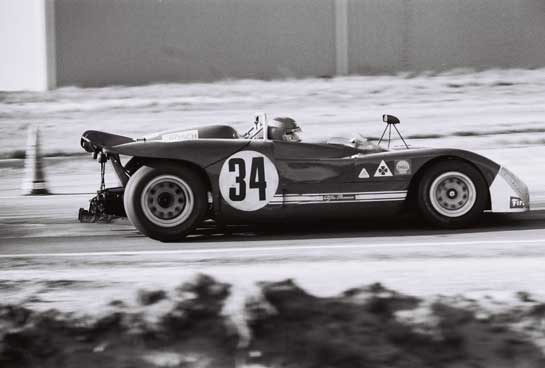
The 33/3 of Vaccarella and Hezemans (#34) retired when the fuel pump failed, completing just 27 laps (140 miles). After #34 retired, team manager Chiti moved Vaccarella to #32, helping de Adamich and Pescarolo to a second overall finish.
Part II continues a look at Alfas racing at Brands Hatch and Silverstone in England and Riverside (Yes, an Alfa in the Can-Am!) in California. With three overall wins at Brands Hatch, the Targa Florio and Watkins Glen and eight prototype 3000 class wins in nine races contested in 1971, Alfa was second to Porsche and its mighty 917 in the championship, giving hope for a better year in 1972 with a 12-cylinder version of the Type 33 on the drawing board.
Part II
Jeff Allison is presently the editor of Prancing Horse, the quarterly magazine of the Ferrari Club of America. He’s previously served in editor positions with MG Abingdon Classics and Vintage Motorsport magazines, including editor of “Vintage Stuff” in Automobile magazine. Since 1976, he’s produced almost 400 articles in over 40 magazines and web sites relating to motorsport activities.
Great photos of a great period of auto racing.
Great pictures Jeff. As I think I told you, I covered the 1971 Endurance Sports Car Series in Europe for “La Razon” a large Argentinian Daily Newspaper and for a little known British magazine called “Auto Race and Rally” – later to become “Auto Enthusiast” but still little known in its reincarnation. I can follow up your pictures from Sebring with some of mine that I still have from the European races in the series.
Hi Jeff —
Really nice work. I didn’t know you shot so many of the later Alfas. To get those pictures you must have had quite a collection of lenses. Plus a very good eye for composition. Congratulations!
— Carl Goodwin
Regarding your disclosure about being the editor of Prancing Horse:
As I am sure you know, but for those who don’t. Without Alfa Romeo, there probably would be no Ferrari; before striking out on his own, Enzo Ferrari worked for Alfa Romeo.
As an owner of a restored 74 GTV, I really appreciate the great photos of the T 33/3 which in either V8 or 12 cyl. configuration made the most beautiful sound I have ever heard. yes,more so than even a Ferrari.
I had the pleasure of seeing the 33/3 up close at the recent Alfa Centenial Reunion , and it brought back many memories.’These cars were incredibly fast but,not always very reliable.
But,when they didn t break,they were always at the front.
The aircraft in the background at Sebring is a transporter Fairchild C-82 Packet.
Congratulations for the fascinating period pictures !
I was leaning toward the aircraft being a C-119 “Flying Boxcar” but stand to be corrected!
Beautiful photos! I doubt that we will ever again see the variety of cars combined with the variety of drivers as we did then. The masters in the masterpieces, if you will.
John
Thanks for some fabulous, evocative Alfa shots – great days.
But you shouldn’t, as Editor of Prancing Horse, feel sheepish about commenting on Alfa Romeos merely as the Italian connection. They were, after all, great cars before Enzo Ferrari and inspired him to make his great creations.
Had Alfa Romeo been more pro-active about the development of their own racing teams, would Ferrari cars ever have existed at all? Who knows?
Jeff:
Another great article derived from you outstanding passion for sports cars and supplemented by your vast library, which I had the pleasure of viewing this summer.
Just remember who showed you around Brands and Silverstone when a paddock pass was 2 quid.
Keep up the good work.
takes me back a bit, exellent photography,congraulations.
Sat in a Alfa Romeo 33 Stradale in 1968-9, AutoDelta Tipo 33 and Alfa Carabo at Otto Zipper’s Alfa Romeo showroom that also had some racing GTA’s and, where I bought my ’69 GTV on Wilshire Boulevard (Beverly Hills). Next door was Bob Estezs’ dealership (Ferrari, Lamborghi, Lancia, Maserati).
Sweet memories!